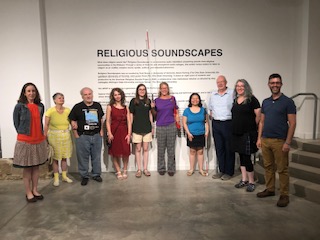Stitches in Faith: Nonvisual Response to Religious Soundscapes
By Elizabeth L. Sammons
In May, I visited Urban Arts Center to hear an exhibit. As someone blessed with an inherent love of art, but without the vision to appreciate it in traditional forms, my experience with museums and their artifacts is always mediated by others. Whether through casual dialogue with sighted friends, or in the more formal realm of audio description available from the exhibiters, my visit is worded with others’ impressions that I must accept in part on trust. Therefore, reading an announcement about Religious Soundscapes, I immediately decided to have a listen. After all, this in many ways would provide my first opportunity to explore an artistic endeavor on my own terms. Additionally, I was curious to find out how a museum would handle a show based not on what meets the eye, but what embraces the ear.
Amidst the barrage of chatter and footsteps echoing off bare floors and walls at the opening, I located “listening mats,” carpets tactically placed under focused speakers. Though that evening, I couldn’t hear much beyond basic impressions, when I complimented museum administrators and exhibit creators on living out the idea of an audio-centric show, they invited me back for a quieter tour. Not wishing to keep such a special opportunity to myself, I planned it for the week a Romanian nonvisual friend would visit in June, meanwhile spreading word through Central Ohio’s blindness community with a mix of emails, radio PSA’s and personal networking.
A few weeks later on a quiet Saturday, a combined group of blind and sighted visitors focused on the sound collage of many of Central Ohio’s little-known faiths, including Eckankar chanting, a Wiccan power cone, and Coptic censer bells, interspersed with a smattering of the familiar, such as a Baptist snippet of Amazing Grace. This cubistic overlap of religions was occasionally overridden with unrelated noises rising to front and center. … the cry of a baby… the splash of rain… the scuttering of a bag on the sidewalk.
I’d like to compare what I heard to what you may see surveying an Amish quilt. While your ocular focus embraces its colors, geometry and condition, my fingers take in the stitching, filling, and types of material used. What you see is more expected than the in-between that my fingertips explore, but arguably, my intake is more complete.
For this reason, the intentional design of overlays and background sounds rising to foregrounds at Religious soundscapes may lead to initial confusion, capturing what sighted visitors generally ignore, but what we as nonvisual listeners use to gain perspective in our environments. While overall audio background has little to do with the faith-based sounds to which our attention inverts nearly by instinct, such uninvited audio, like stitches in a quilt, nevertheless runs through the fabric of any faith in the steady weaving together of humanity. Whether echoing around the cold stone walls in a cathedral, or shielded in the warm field grass at a powwow, A cricket’s voice sings with our own. Those gathered choose to discount, or in the case of this exhibit, to recount, possibly even to rejoice in its existence amidst our human hunt for holiness.

About the writer:
Doctors told Elizabeth Sammons’ parents to institutionalize her at birth; she was blind. Instead, they raised her with faith, a sense of self-respect and wonder, and a vast array of books. After graduating with a master’s degree in journalism from the Ohio State University, she worked with nonprofit and teaching in Russia and Central Europe, including Peace Corps, returning to a career in state and federal public service in her native Ohio.
Sammons’ writings and research have been featured in “Ethics in Journalism,” “Plough Quarterly,” and “The Columbus Dispatch,” among others. Her first novel, The Lyra and the Cross was published in 2019.


